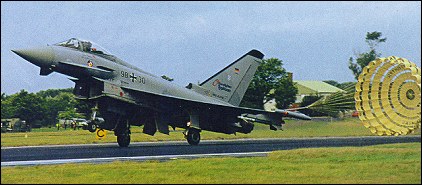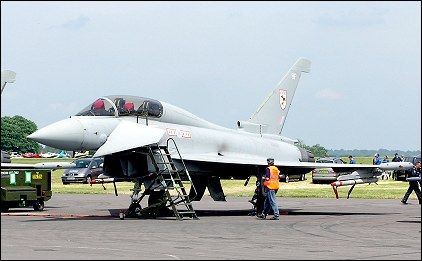 |
Eurofighter Typhoon1994 |  |
| FIGHTER | Virtual Aircraft Museum / Joint Projects / Eurofighter |
 |
In October 1981, the Royal Air Force Operational Requirements Branch began planning for a next-generation fighter to replace the F-4 Phantom in the air defence role and the Jaguar in the offensive support role. The need crystallized in Air Staff Requirement (Air) 414, which specified a short-range, highly agile air defence/offensive support aircraft. The European Fighter Aircraft (EFA) programme was the project that met this requirement. An outline staff target for a common European fighter aircraft was issued in December 1983 by the air chiefs of staff of France, Germany, Italy, Spain and the UK; the initial feasibility study was completed in July 1984, but France withdrew from the project a year later. A definitive European Staff Requirement (Development), giving operational requirements in greater detail, was issued in September 1987; the main engine and weapon system development contracts were signed in November 1988. To prove the necessary technology for EFA, a contract was awarded in May 1983 to British Aerospace for development of an agile demonstrator aircraft - not a prototype - under the heading Experimental Aircraft Programme, or EAP. The cost was to be shared between the partner companies of the EFA consortium and the UK Ministry of Defence (MoD). The EAP demonstrator flew for the first time on 8 August 1986, only three years after the programme was conceived. The task of Eurofighter, as EFA ultimately became known, is to fight effectively throughout the combat spectrum, from engagements beyond visual range down to close-in combat. The technologies that enable it to do this are so advanced, and in some cases so unique, that the role of the EAP aircraft was vital to the Eurofighter project as a whole. The Cold War's end led, in 1992, to a reappraisal of the programme. Germany in particular demanded substantial cost reductions. Several low-cost configurations were examined, but only two were cheaper than the original EFA, and both were inferior to the MiG-29 and Su-27. Finally, in December 1992, the project was re-launched as Eurofighter 2000, the planned in-service entry having now been delayed by three years. To engage targets, particularly in the vital beyond-visual-range battle, the aircraft is equipped with the Euroradar ECR90 multimode pulse-Doppler radar. The ECR90 is designed to minimize pilot workload: radar tracks are presented constantly, analysed, allocated priority or deleted by track-management software. A third-generation coherent radar, the ECR90 benefits from a considerable increase in processing power and has all-aspect detection capability in look-up and look-down modes; it also has covert features to reduce the risk of detection by enemy radar-warning receivers. The first two Eurofighter prototypes flew in 1994, followed by several more. The original customer requirement was 250 each for the UK and Germany, 165 for Italy and 100 for Spain. Spain announced a firm requirement for 87 in January 1994, while Germany and Italy revised their respective needs to 180 and 121, the German order to include at least 40 examples of the fighter-bomber version. The UK's order was 232, with options on a further 65 aircraft. Deliveries to the air forces of all four countries were scheduled to begin in 2001, but not for the first time the schedule slipped. The RAF received its first aircraft on 30 June 2003. Eurofighter has broken into the export market with an Austrian order for 35 aircraft.
|  All the World's Rotorcraft | |||||||||||||||||||||||||||||||||||||||||||||
 |

|
